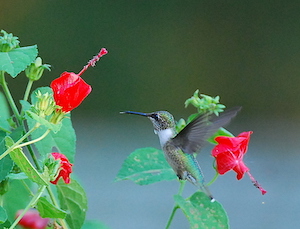
By Terry W. Johnson
I strongly believe that if a survey were conducted to determine which bird is the favorite of most Georgians, when all the votes were tabulated the winner would be the ruby-throated hummingbird. While this tiny flying jewel only spends a few short months with us each year, its breathtaking beauty, feisty attitude and aerial acrobatics occupies a special place in our hearts.
It almost goes without saying that the ruby-throated hummingbird's departure each year leaves us anxiously awaiting its return the following March. Yet more often than not, we give little thought as to where this bird spends the winter. Perhaps this is due, in part, to the fact we assume that winter home is much like the places where we are accustomed to seeing it.
Actually, when biologists were finally able to find and describe the habitat occupied by ruby-throated hummingbirds after they leave the U.S. each year, it was quite different from what many of us imagined.
It seems the vast majority of the ruby-throated hummingbird population winters from southern Mexico southward across Central America to Panama. Smaller numbers spend their winter sojourn in the West Indies. Studies have also revealed that, for the past 25 years, the ruby-throat has expanded its winter range across extreme south Florida. Each winter, small numbers also regularly winter along the Gulf and Atlantic coasts, as far north as South Carolina. I have personally captured and banded ruby-throats wintering from the Georgia coast to as far west as Thomasville.
Meanwhile, while we are familiar with the newly expanded winter habitats in the Southeast, we are only beginning to identify the habitats used by the vast majority of the birds that leave the U.S. each year.
One of these environments is shade-grown coffee farms. Here, coffee plants are grown in the shade of native forest trees. The ruby-throated hummingbird is but one of scores of neotropical migratory songbirds (birds that breed in North America but winter in the neotropics) that also winter on these farms. One study conducted in Nicaragua found literally hundreds bird species (migrants and permanent residents) inhabiting a single 90-acre, environmentally friendly coffee farm.
Unfortunately, the vast majority of the coffee we drink is brewed from beans harvested on traditional coffee plantations. These plantations are created by clear-cutting and burning native trees, thereby transforming the landscape into open fields that are then planted with coffee plants.
In other areas throughout Central America, ruby-throated hummingbirds spend their time in locations—open hardwood forests, stream corridors and forest and field edges—that are a far cry from the backyards throughout eastern North America that many spend summers in. Hundreds of miles to the south, ruby-throats winter in a wide range of habitats, including dry forests, brushy fencerows and scrubby landscapes. They also occupy citrus groves.
Anyone who feeds hummingbirds in spring and summer knows ruby-throated hummers establish feeding territories. And each is territory is vigorously defended by the bird that has staked a claim to it.
It seems ruby-throats do the same in the heart of their wintering grounds. However, the problem is that while during spring and summer the only other birds they have to compete for nectar with are other ruby-throats bent on feeding at the same feeders and nectar plants found in their domain, during winter they face far more competition. For example, a ruby-throated hummingbird wintering in Panama has to contend with the likes of other ruby-throats plus 59 other species of hummingbirds. One has to wonder how it can even find time to eat when it seemingly must be constantly engaged in aerial battles with other hummingbirds.
Fortunately, throughout much of Central America, insects and small spiders are abundant. These protein-rich tiny invertebrates supplement the bird's nectar diet.
Ruby-throated hummingbirds must also deal with much different predators than they do in Georgia. Recently, the comments of a blogger who lives Mexico and was responding to one of my posts on backyardwildlifeconnection, a blog sponsored by The Environmental Resources Network (TERN), showed just how different the predators are. The blogger mentioned a spiny-tailed iguana feasting on two hummingbirds at a feeder, while ferruginous pigmy-owls had taken more than 10 hummers from the yard!
Conservationists are concerned that the destruction of quality winter habitat in southern Mexico along with the heavy use of pesticides, destruction of forests to create traditional coffee plantations and other agricultural uses, and global warming will all have a severe impact on ruby-throated hummingbirds. Since these threats continue unabated, it is uncertain what the long-range effect will be on hummers and other wildlife.
Meanwhile, the ruby-throated hummingbird population seems to be doing very well.
Data collected in Breeding Bird Surveys over the past 40 years reveal that the ruby-throated hummingbird population has increased an average of 25 percent per decade. The breeding population of ruby-throated hummingbirds is currently estimated at 20 million birds.
Let's hope the ruby-throated hummingbird's breeding and wintering grounds remain healthy enough to allow this species to flourish for decades to come. In the meantime, we coffee drinkers should consider drinking more shade-grown coffee. Every sip of shade-grown coffee should taste a little better knowing we are helping conserve our favorite bird.
Terry W. Johnson is a former Nongame program manager with the Wildlife Resources Division and executive director of The Environmental Resources Network, or TERN, friends group of the division’s Nongame Conservation Section. (Permission is required to reprint this column.) Learn more about TERN, see previous “Out My Backdoor” columns, read Terry’s Backyard Wildlife Connection blog and check out his latest book, “A Journey of Discovery: Monroe County Outdoors.”





